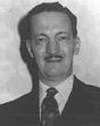Omnilingual


"Omnilingual" is a science fiction short story written by H. Beam Piper.[1] This short story was originally published in the February 1957 issue of Astounding Science Fiction.[2] This short story is unusual in focussing on the problem of archaeology on an alien culture.[3]
Synopsis
An expedition from Earth to Mars discovers a deserted city, the remains of an advanced civilization that died out 50,000 years before. The human scientists recover books and documents left behind, and are puzzled by their contents. Earnest young archeologist Martha Dane deciphers a few words, but the real breakthrough comes when the team explores what appears to have been a university in which the last few civilized Martians made their last stand. Inside, they find a "Rosetta Stone": the periodic table of the elements.[4] The story builds tension from the skepticism of the rest of the team, mostly male, as well as from Ms. Dane's competitive, spotlight-seeking team-mate, Tony Lattimer.
Themes
The point of the story, reflected in the title, is that science is an "omnilingual", or "all language" text. Translations of "dead" languages tend to rely on "bilingual" texts where the same message is written in both the dead language and a known language, allowing deduction of the meaning of symbols in the dead language by finding the corresponding symbols in the known language. The Rosetta Stone, for instance, contains texts in ancient hieroglyphics, more recent Egyptian script, and ancient Greek.
As the story points out, even pictures with captions are not necessarily helpful, giving the example of a picture of a man using a hand saw. The caption could mean anything from "man sawing wood" to "Kaiser Wilhelm in exile".
In the story, Martian is discovered to be somewhat like German, in that words are constructed from other words. It is also regular and free of loanwords, unlike English. Thus in German the words for hydrogen ("Wasserstoff"), carbon ("Kohlenstoff"), nitrogen ("Stickstoff"), and oxygen ("Sauerstoff"), contain a common root word. In Martian the archaeologists quickly identify root words meaning "matter" or "element", and also "metal" by deciphering the names of elements in the Martian version of the Periodic Table. They encounter words such as "Of-metal-matter-knowledge", which can only mean "metallurgy". The table also gives them a clear understanding of the Martian number system, because it is arranged in a known way based on numbers. They then deduce that the Martian calendar divided the year in to ten periods named for the numbers 1 to 10, and are able to identify scientific journals by their publication date.
Publication history
Omnilingual has been reprinted several times since its original publication.
- Prologue to Analog (1962, Doubleday)
- Analog Anthology (1965, Dobson)
- Great Science Fiction Stories About Mars (1966, Fredrick Fell)
- Apeman, Spaceman (1968, Doubleday)
- Mars, We Love You (1971, Doubleday) - Also published under the title The Book of Mars
- Where Do We Go from Here? (1971, Doubleday)
- The Days After Tomorrow (1971, Little Brown)
- Tomorrow, and Tomorrow, and Tomorrow... (1974, Rinehart & Winston)
- Science Fiction Novellas (1975, Scribner)
- Federation (1981, Ace)
- The Great SF Stories: 19 (1957) (1989, DAW)
- The World Turned Upside Down (2005, Baen)
See also
References
- ↑ Piper, Henry (1957). Omnilingual. General Books.
- ↑ Walton, Jo. "Scientific Language: H. Beam Piper's "Omnilingual"". Tor.com. Retrieved 28 March 2012.
- ↑ Wilkins, Alasdair. "Digging Deep: 24 Science Fiction Archaeologists". Io9. Retrieved 28 March 2012.
- ↑ At the time, the periodic table had only 92 elements.
External links
- Omnilingual title listing at the Internet Speculative Fiction Database
- Omnilingual at Project Gutenberg
-
 Omnilingual public domain audiobook at LibriVox
Omnilingual public domain audiobook at LibriVox - Omnilingual title listing at the Internet Speculative Fiction Database
- Unofficial edited version